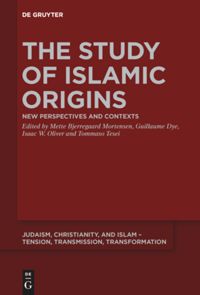Bjerregaard Mortensen (Mette), Dye (Guillaume), Oliver (Isaac W.), Tesei (Tommaso) eds., The Study of Islamic Origins : New Perspectives and Contexts, Berlin, De Gruyter, ("Judaism, Christianity, and Islam – Tension, Transmission, Transformation, 15"), 2021, 376 p. ISBN 978-3110675436
Editeurs
Bjerregaard Mortensen (Mette), Université Libre de Bruxelles
Dye (Guillaume), Université Libre de Bruxelles
Oliver (Isaac W.), Bradley University
Tesei (Tommaso), Duke Kunshan University
Présentation

The study of Islam’s origins from a rigorous historical and social science perspective is still wanting. At the same time, a renewed attention is being paid to the very plausible pre-canonical redactional and editorial stages of the Qur’an, a book whose core many contemporary scholars agree to be formed by various independent writings in which encrypted passages from the OT Pseudepigrapha, the NT Apocrypha, and other ancient writings of Jewish, Christian, and Manichaean provenance may be found. Likewise, the earliest Islamic community is presently regarded by many scholars as a somewhat undetermined monotheistic group that evolved from an original Jewish-Christian milieu into a distinct Muslim group perhaps much later than commonly assumed and in a rather unclear way. The following volume gathers select studies that were originally shared at the Early Islamic Studies Seminar. These studies aim at exploring afresh the dawn and early history of Islam with the tools of biblical criticism as well as the approaches set forth in the study of Second Temple Judaism, Christian, and Rabbinic origins, thereby contributing to the renewed, interdisciplinary study of formative Islam as part and parcel of the complex processes of religious identity formation during Late Antiquity.
Content
Frontmatter
Contents
Introduction
Mette Bjerregaard Mortensen, Guillaume Dye, Isaac W Oliver and Tommaso Tesei
I EARLY ISLAM AND THE QUR’ĀN : METHODOLOGICAL CONSIDERATIONS
The Current Status and Problems of Islamic Origins
Aaron W. Hughes
A New Arabic Apocryphon from Late Antiquity : The Qurʾān
Stephen J. Shoemaker
II EARLY ISLAM AND THE QUR’ĀN : HISTORICAL, LITERARY, AND CROSS-COMPARATIVE ANALYSES
Body Parts Nomenclature in the Qur’anic Corpus
Manfred Kropp
The Queen of Sheba in the Qur’ān and Late Antique Midrash
Jillian Stinchcomb
Standing under the Mountain : Jewish and Christian Threads to a Qur’anic Construction
Isaac W. Oliver
Mapping the Sources of the Qur’anic Jesus
Guillaume Dye
The Natural Theology of the Qur’ān and Its Late Antique Christian Background : A Preliminary Outline
Julien Decharneux
III EARLY ISLAM AND THE QUR’ĀN : SOCIAL, POLITICAL, AND RELIGIOUS CONTEXTS
Q 2:102, 43:31, and Ctesiphon-Seleucia
Gilles Courtieu and Carlos A. Segovia
Prophecies Fulfilled : The Qur’anic Arabs in the Early 600s
Peter von Sivers
The Sasanian Conquest of Ḥimyar Reconsidered : In Search of a Local Hero
Boaz Shoshan
Contextual Readings of Religious Statements in Early Islamic Inscriptions
Marcus Milwright
The Gods of the Qur’ān : The Rise of Ḥijāzī Henotheism during Late Antiquity
Valentina A. Grasso
“One Community to the Exclusion of Other People” : A Superordinate Identity in the Medinan Community
Ilkka Lindstedt
List of Contributors
